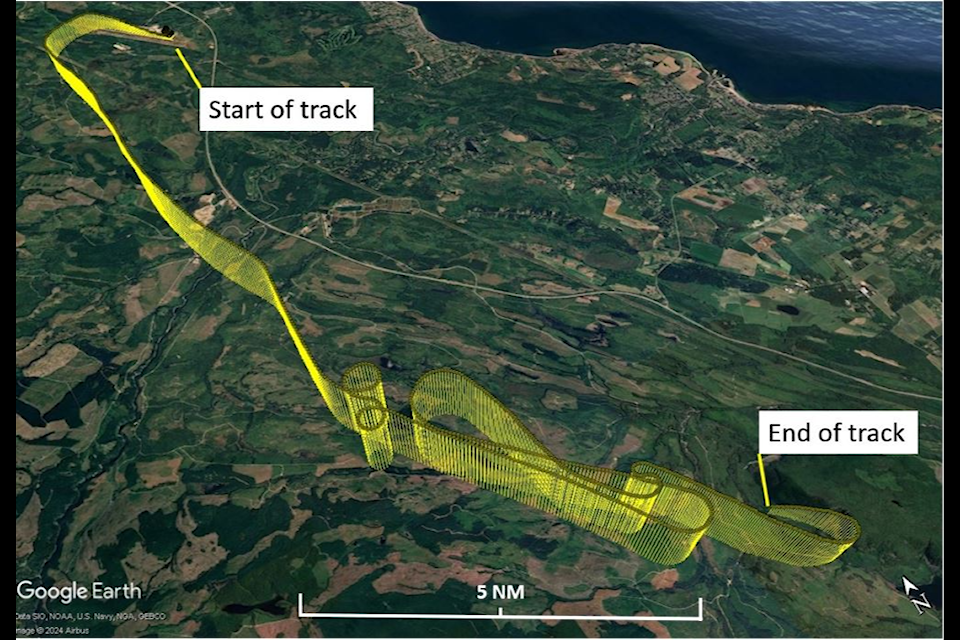The Transportation Safety Board of Canada found modifications that were not properly recorded prior to a plane crash near Campbell River last September.
The aircraft, registered to Sealand Aviation, had two pilots on board and was equipped with a RED A03-005 reciprocating diesel engine manufactured by Raikhlin Aircraft Engine Developments GmbH (Red) of Germany. The engine was a prototype design developed by Sealand Aviation. The modification in question was the engine.
Transport Safety Board of Canada carried out an investigation to advance transportation safety and not to assign fault or determine civil or criminal liability. The report says the flight had two permits from Transport Canada, an experimental permit and a specific purpose permit. The report says "the modifications did not comply with the intended conditions and limitations specified by the permits."
The pilot-in-command (PIC) was familiar with the aircraft, and the co-pilot was an accredited test pilot involved in the flight to become familiar with the plane for future participation in future tests for the prototype aircraft.
A power-off stall was conducted roughly 4,000 feet above sea level at 10:31 a.m. During recovery from the stall, the engine failed to produce sufficient thrust to maintain the aircraft's altitude and the pilots were forced into an emergency landing. The plane came to a rest in a heavily wooded area, around 10 nautical miles (or 18.5 kilometres) south-southeast of the Campbell River airport. Both pilots were able to exit the vehicle with minor injuries. However, a search and rescue helicopter took them to the hospital. The weather was not considered as a factor in the crash.
The aircraft was significantly damaged, but there was no post-impact fire. The emergency locator transmitter was also activated.
The wreckage showed signs consistent with a forced landing. The wings and landing gear were separated from the body of the plane, and all the propellor blades showed damage consistent with propeller rotation on impact. The fuel tanks in the belly of the aircraft were damaged. It is unknown how much fuel was released, and the occupiable space within the fuselage was not compromised.
The investigation found the seat and restraints functioned as intended. However, several exits were unusable due to fuselage compression or obstruction due to debris and terrain. The left cockpit door was how the two pilots managed to exit the crashed plane unassisted.
According to the investigation, investigators found no indication that the performance of either pilot was affected by medical or physiological factors. The PIC had the appropriate license and rating for the flight and had more than 8,500 flight times hours before the flight. Out of those hours, 3,600 were on the conventionally-powered DHC-2 aircraft and 20 on the prototype.
The co-pilot holds an airline transport pilot license with ratings for land and seaplanes and had 15,000 total flight hours before the flight.
The aircraft was originally built in 1954 and operated by the United States Army before it was sold to a civilian operator in the U.S. in the 1970s. In June 2020, Sealand Aviation privately registered the aircraft in Canada. It was then partially disassembled and rebuilt and equipped with the RED A03-005 engine. The engine is a 12-cylinder, twin-turbocharged, high-compression-ignition engine with two six-cylinder banks capable of independent operation. A full-authority digital engine control (FADEC) system controls the engine, which is controlled by an electronic engine control unit (EECU). A cockpit lever commands the engine power and the blade angle of the reversing MT-Propeller GmbH MTV-9-E-C-R(M) variable-pitch propeller driven by the engine. The propeller rotates counterclockwise at a maximum of 2,127 rpm.
The engine is certified by the European Union Aviation Safety Agency and by the U.S. Federal Aviation Administration. However, at the time of the crash, a Canadian body had not certified it. Transport Canada authorized its use for Canadian-registered occurrence aircraft subject to the conditions stipulated in two flight permits issued to Sealand Aviation by Transport Canada. The two permits were an experimental flight permit and a specific-purpose flight permit. The investigation concluded modifications to the plane did not comply with the permits.
Transport Safety Board of Canada warns aircraft owners and operators to record all maintenance as a reliable method for determining an aircraft's airworthiness and status.
The full report can be read here.



